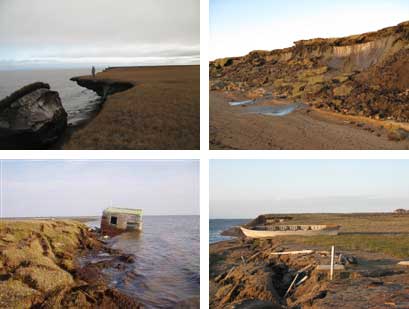Erosion Rate Doubles on Stretch of Alaskan Coast

Most of California isn't falling into the sea yet, but big parts of Alaska are.
In a possible sign of things to come, erosion of a stretch of Alaska's coast surged in recent years to more than double the average historical rate, threatening some towns, a new study finds. The loss of land is documented in photos that show newly collapsed sections of permafrost coastline as well as decades-old artifacts that have slipped into the sea.
Scientists caution that the study does not include the entire coastline, but they said the shift might be due to declining Arctic sea ice extent, increasing summertime sea-surface temperatures, the rising sea level, and increases in storm power and corresponding wave action.
"These factors may be leading to a new era in ocean-land interactions that seem to be repositioning and reshaping the Arctic coastline," the scientists write in the Feb. 14 issue of the journal Geophysical Research Letters.
The details
The study involved a 64-kilometer (40-mile) stretch of the Beaufort Sea. Researchers compared the period 2002 through 2007 to average erosion rates during two previous periods.
The details:
Get the world’s most fascinating discoveries delivered straight to your inbox.
Average annual erosion rates along the area studied had already climbed from about 20 feet (6.1 m) per year during the 1950, 60s and 70s to 28 feet (8.5m) per year in the period from the late-1970s to the early 2000s. The most recent erosion rates reached an average of 45 feet (14 meters) per year during the 2002 to 2007 period, said Benjamin Jones, a geologist with the U.S. Geological Survey in Anchorage.
They also documented sections of coastline that eroded more than 80 feet (24 meters) during 2007 alone.
The researchers caution that the pattern may not be representative of the overall Arctic. However, it may well forecast the future pattern of coastline erosion in the region, they said.
"This segment of coastline has historically eroded at some of the highest rates in the circum-Arctic, so the changes occurring on this open-ocean coast might not be occurring in other Arctic coastal settings," Jones said. But Arctic climate change is leading to rapid and complex environmental responses in both terrestrial and marine ecosystems in ways that will almost certainly affect the rate and pattern of coastline erosion in the Arctic, the authors write.
Interestingly, there were no westerly storm events during the summer of 2007, traditionally thought to be the drivers of coastal erosion in this region the Arctic. However, 2007 did boast the minimum arctic sea-ice extent and the warmest ocean temperatures on record.
Slipping into the sea
Jones and his coauthors verified in another recent study the disappearance of cultural and historical sites along the same stretch of the Beaufort Sea. Those sites include Esook, a turn-of-the-century trading post now buried in the sea and Kolovik (Qalluvik), an abandoned Inupiaq village site that may soon be lost.
At another site, near Lonely, Alaska, Jones snapped a picture of a wooden whaling boat that had rested on a bluff overhanging the ocean for nearly a century. A few months later the boat had washed away to sea. That study was published in the journal Arctic.
"The recent trends toward warming sea-surface temperatures and rising sea-level may act to weaken the permafrost-dominated coastline by helping more quickly thaw ice-rich coastal bluffs and may potentially explain the disproportionate increase in erosion along ice-rich coastal bluffs relative to ice-poor coastal bluffs that we documented in our study," Jones said.
"Any increases in already rapid rates of coastal retreat will have further ramifications on Arctic landscapes — including losses in freshwater and terrestrial wildlife habitats, in subsistence grounds for local communities, and in disappearing cultural sites," he said, "as well as adversely impacting coastal villages and towns. In addition, oil test wells are threatened."
{{ video="080404-sea-ice" title="Global Melt Seen from Orbit" caption="Environmental monitoring satellites track warming by watching polar ice. Credit: ESA" }}
- Video: Melting Sea Ice Seen from Orbit
- Top 10 Surprising Results of Global Warming
- Quiz: Global Weather Extremes



